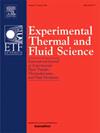Experimental investigation of fuel adhesion from wall-impinging spray with various injection mass ratios
IF 2.8
2区 工程技术
Q2 ENGINEERING, MECHANICAL
Experimental Thermal and Fluid Science
Pub Date : 2024-12-27
DOI:10.1016/j.expthermflusci.2024.111403
引用次数: 0
Abstract
In direct injection spark ignition (DISI) engines, interactions between spray and wall surfaces are a common phenomenon. This interaction results in fuel adhering to the surfaces of the cylinder and piston, which in turn greatly influences both combustion efficiency and emission levels. This work explored the influence of various injection mass ratios (D25-75, D50-50, D75-25) on fuel adhesion properties, employing the refractive index matching (RIM) technique in both non-evaporation and evaporation environments. Findings indicated that the split injection mass ratios notably affected fuel adhesion. Under the non-evaporation condition, the highest adhesion mass ratio was observed for D50-50, which was 14.5 %, whereas D25-75 and D75-25 exhibited adhesion mass ratios of 11.9 % and 12.5 % at 60 ms after the start of injection (ASOI). This increase was attributed to two factors: “fuel adhesion thickness” and “penetration velocity”, both of which contributed to enhance splashing and ultimately resulted in the highest adhesion mass of D50-50. However, under the evaporation condition, the adhesion mass of D50-50 declined quickly in comparison to those of other injection mass ratios. This rapid decrease was caused by the uneven adhesion of D50-50, which tended to collapse and evaporate faster at high ambient temperatures, as the uniformity of D50-50 was poorer than those of other injection mass ratios.
不同喷油质量比对撞壁喷雾燃油粘附性能的实验研究
在直喷式火花点火(DISI)发动机中,喷雾与壁面之间的相互作用是一种常见现象。这种相互作用导致燃料粘附在气缸和活塞表面,这反过来又极大地影响了燃烧效率和排放水平。在非蒸发和蒸发两种环境下,采用折射率匹配(RIM)技术,研究了不同喷射质量比(D25-75、D50-50、D75-25)对燃料粘附性能的影响。结果表明,劈裂喷射质量比显著影响燃油黏附。在非蒸发条件下,D50-50的黏附质量比最高,为14.5%,而D25-75和D75-25在注射后60ms的黏附质量比分别为11.9%和12.5%。这种增加归因于两个因素:“燃料粘附厚度”和“穿透速度”,这两个因素都有助于增强飞溅,最终导致D50-50的最大粘附质量。但在蒸发条件下,D50-50的黏附质量较其他注射质量比下降较快。这种快速下降是由于D50-50的粘附不均匀造成的,在较高的环境温度下,D50-50的均匀性比其他注射质量比差,容易坍塌和蒸发。
本文章由计算机程序翻译,如有差异,请以英文原文为准。
求助全文
约1分钟内获得全文
求助全文
来源期刊

Experimental Thermal and Fluid Science
工程技术-工程:机械
CiteScore
6.70
自引率
3.10%
发文量
159
审稿时长
34 days
期刊介绍:
Experimental Thermal and Fluid Science provides a forum for research emphasizing experimental work that enhances fundamental understanding of heat transfer, thermodynamics, and fluid mechanics. In addition to the principal areas of research, the journal covers research results in related fields, including combined heat and mass transfer, flows with phase transition, micro- and nano-scale systems, multiphase flow, combustion, radiative transfer, porous media, cryogenics, turbulence, and novel experimental techniques.
 求助内容:
求助内容: 应助结果提醒方式:
应助结果提醒方式:


